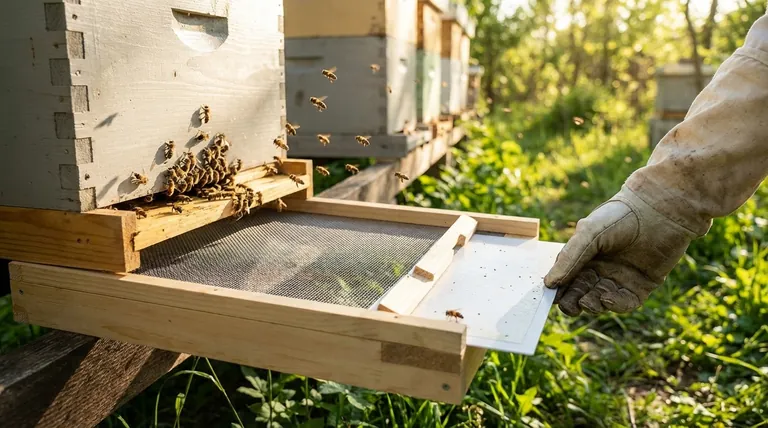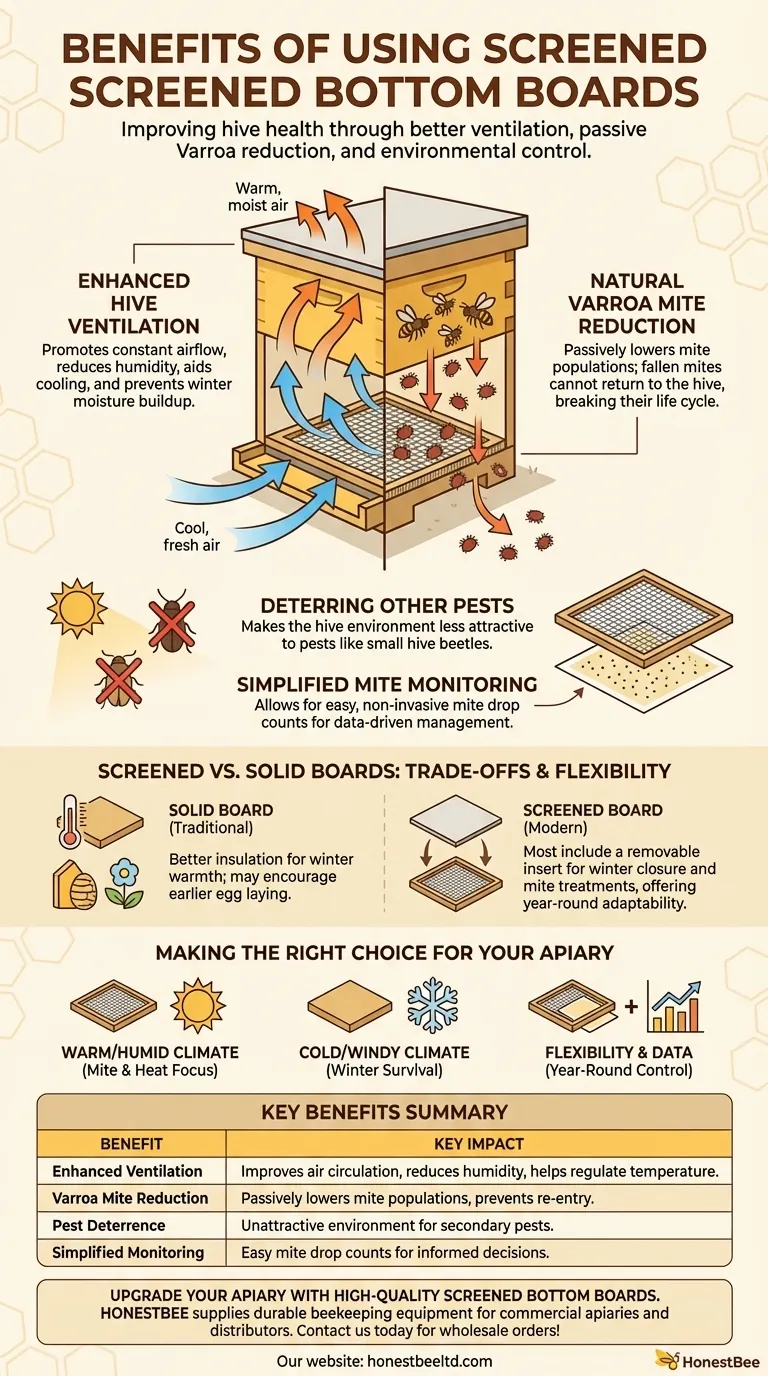The primary benefits of using screened bottom boards are improved hive ventilation, passive reduction of Varroa mite populations, and better temperature regulation for the colony. They effectively create a healthier, drier internal environment by allowing air to circulate and pests or debris to fall out of the hive.
The choice between a screened or solid bottom board is not about which is universally "better," but about which tool gives you more control over your hive's specific environment. A screened bottom board is fundamentally a tool for managing ventilation and pests.

The Primary Advantage: Superior Environmental Control
A screened bottom board replaces the traditional solid wood floor of a beehive with a sturdy wire screen. This simple change has significant impacts on the conditions inside the hive.
Enhanced Hive Ventilation
A constant, gentle airflow is critical for a colony's health. The screen allows for passive air exchange, which helps manage the hive's internal climate.
This is especially beneficial in hot, humid weather, as it helps the bees cool the hive more efficiently and reduces the energy they must expend on fanning. It also helps reduce condensation during the winter, preventing moisture from dripping down onto the cluster.
Natural Varroa Mite Reduction
The Varroa destructor mite is one of the greatest threats to honey bee health. A screened bottom board is a key component of an Integrated Pest Management (IPM) strategy.
When mites lose their grip and fall from a bee, they drop through the screen and onto the ground. This prevents them from climbing back into the hive to find a new host, breaking their life cycle and reducing the overall mite load within the colony.
Deterring Other Pests
Some secondary pests, like the small hive beetle, prefer dark, damp conditions. The increased light and airflow from a screened bottom board can make the hive environment less attractive to them.
Understanding the Trade-offs: Screened vs. Solid Boards
While highly beneficial, screened bottom boards are not without their considerations. Understanding their drawbacks in contrast to solid boards is key to making an informed decision.
Winter Warmth and Spring Buildup
A solid bottom board offers better insulation, which can help a colony retain heat more easily during a cold winter. This retained warmth may also encourage a queen to begin laying eggs earlier in the spring.
However, most modern screened bottom boards come with a removable insert (often a plastic or corrugated board) that can be used to close the screen during winter, effectively turning it into a solid bottom board and negating this disadvantage.
Bee Behavior and Clustering
In very hot weather, bees may cluster underneath the screen on the outside of the hive (a behavior known as "bearding"). This is generally harmless but can be concerning for new beekeepers.
Mite Treatment Efficacy
Some mite treatments, particularly vapor-based ones like those using oxalic or formic acid, require a sealed hive to be fully effective. If you use a screened bottom board, you must use the removable insert to seal the bottom during these treatments.
Practical Management Considerations
Beyond environmental control, a screened bottom board changes how you can interact with and monitor your hive.
Simplified Mite Monitoring
Placing a "sticky board" (a white, sticky insert) under the screen for 24-48 hours allows you to perform a mite drop count. This is a non-invasive way to estimate the hive's mite population and determine if treatment is necessary, allowing for more data-driven beekeeping.
Reduced Debris Buildup
Debris like wax cappings and pollen naturally fall through the screen, helping to keep the hive cleaner compared to a solid board where this material can accumulate and potentially harbor pests or mold.
Making the Right Choice for Your Apiary
Your local climate and management goals should guide your decision.
- If your primary focus is managing pests naturally in a warm or humid climate: A screened bottom board is an essential tool for passive mite reduction and superior ventilation.
- If your primary focus is maximizing winter survival in a very cold, windy climate: A solid bottom board may offer a slight advantage, though a screened board with an insert provides far more year-round flexibility.
- If your primary focus is flexibility and data-driven beekeeping: A screened bottom board with a removable insert is the superior choice, offering insight through mite counts and adaptability to any season.
Ultimately, equipping your hive with the right foundation gives you the control needed to help your colony thrive.
Summary Table:
| Benefit | Key Impact |
|---|---|
| Enhanced Ventilation | Improves air circulation, reduces humidity, and helps bees regulate hive temperature more efficiently. |
| Varroa Mite Reduction | Passively lowers mite populations by preventing fallen mites from re-entering the hive. |
| Pest Deterrence | Makes the hive less attractive to pests like small hive beetles through increased light and airflow. |
| Simplified Monitoring | Allows for easy mite drop counts with a sticky board for data-driven hive management. |
Ready to upgrade your apiary with high-quality screened bottom boards? HONESTBEE supplies durable, well-designed beekeeping equipment—including screened bottom boards with removable inserts for year-round flexibility—to commercial apiaries and beekeeping equipment distributors. Our wholesale-focused operations ensure you get reliable gear that supports healthier, more productive colonies. Contact us today to discuss your needs and place an order!
Visual Guide

Related Products
- Langstroth Screen Bottom Board for Beekeeping Wholesale
- Australian Pine Wood Langstroth Screen Bottom Board for Wholesale
- Langstroth Solid Bottom Board for Beekeeping
- Professional Bamboo Queen Isolation Cage
- Boardman Entrance Bee Feeder Durable Galvanized Steel and Wood Construction for Beekeeping
People Also Ask
- What are the advantages of a screened bottom board? Boost Hive Health with Superior Ventilation & Pest Control
- How should the screened bottom board be used throughout the year? A Guide for Healthy Hives
- What are the assembly options for the Cypress Screened Bottom Board? Ready-to-Use for Immediate Hive Health
- What are some considerations when choosing between solid and screened bottom boards? Optimize Hive Health & Pest Control
- What are the benefits of a screened bottom board? Boost Hive Health & Control Varroa Mites



















